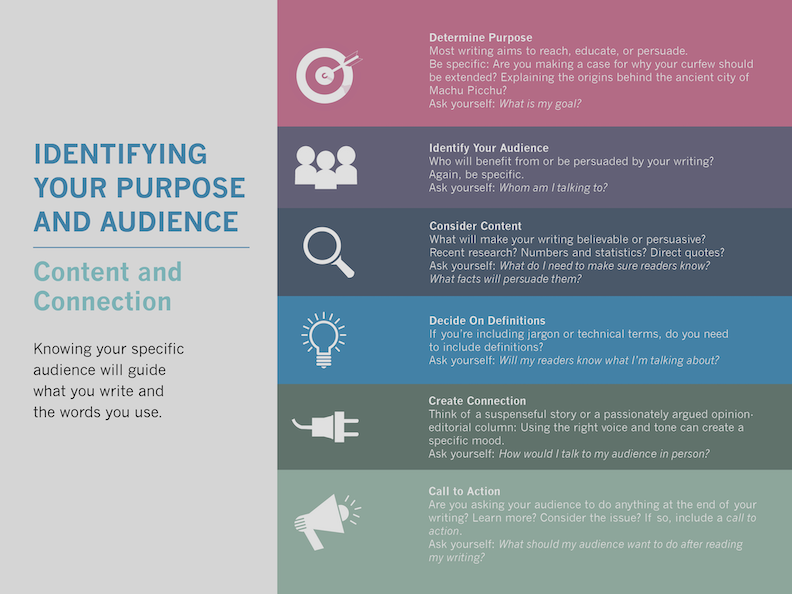Overview
Grades will be awarded using the College’s standard grading scale, but evaluation of your coursework will take into consideration effort applied, participation, and creative use of resources. Your final grade will reflect how well you explored and demonstrated the concepts and practices introduced in this course.
Grades will be posted on the class site using either Blackboard Grade Center and/or OpenLab Gradebook. Your instructor will provide timely feedback via comment or email.
Grades will be based upon:
- Reading Responses 25%
- Research Papers 20%
- Research Journal 10%
- Research Project & Presentation 25%
- Productivity & Participation 20%
Course Assignments
Weekly readings and written reading responses are central to this course. Completing every reading is necessary for the successful completion of the course. Your weekly written responses, two short papers, and class discussions will be posted to the class website. The course will also require independent research using a Research Journal and will culminate in a Research Project and Presentation.
Weekly Reading Responses (25%)
Each weekly reading will be posted on the class site and will include a set of questions or prompts intended to promote critical engagement and class discussion using Hypothesis and OpenLab. You will be expected to write a 3-4 paragraph comment reflecting on the text presented and provide feedback on your peers’ reflections in Discussions. Responses with links to Hypothesis annotations must be submitted to the class site on the date due.
Research Papers (20%)
Twice during the semester, in lieu of the weekly reading response, you will submit a Research Paper, 2-3 pages (750-1000 words) in length, typed in double-spaced 12 pt Times New Roman, with all references and quotations properly cited according to MLA guidelines. These papers will be formally structured essays concerning assigned readings and your individual research. These readings may relate to your research topic and/or may take the form of an exploratory essay to help guide your research.
Research Journal (10%)
Each week you will add to your online Research Journal, documenting and critically reflecting on your influences, history, culture, likes, and dislikes. This practice of being curious about your own design aesthetic is a way to gain experience engaging with critical design theory. Your Research Journal is a place for collecting ideas, freewriting, images, links, videos, and other media to help you develop your ideas and formulate your research topic. It can also be a place to reflect on the readings and write your rough drafts before they are put into a formal post, comment, or paper.
Your journal may be private or public throughout the semester but it should be submitted at the midterm and end of the semester for review.
Research Project & Presentation (25%)
By Week 7, you will present a well-defined research topic and outline of a final research project to be presented in class and/or posted on the class site for feedback.
In the final three weeks of class, you and your peers will present your independent research. You will be expected to articulate a clearly defined topic concerning contemporary design and theory, by way of a well-designed poster or slide deck with voice or video narration. Your research project should serve as an opportunity to connect your own design practice with professional research methodologies and the design theory presented in this course.
The research project and presentation will:
- include a 5-10 minute slideshow and audio/video presentation
- demonstrate professional research practices (written, verbal, visual)
- connect graphic design history and theory with the contemporary design field
- demonstrate a connection between your design practice and theoretical concepts covered in the course
- include an outline, annotated bibliography and glossary
- demonstrate methods of primary and secondary source evaluation
Productivity & Participation (20 %)
Discussions of assigned readings will play a critical role in this course. Class conversations, whether face to face or asynchronous, should not only provide a better understanding of the readings but should also make the course more engaging for everyone.
Effective participation is demonstrated by:
- Posting and commenting on the shared class site by the set deadline, including contributing to discussions, or giving peer feedback.
- Actively participating in group annotations, presentations and discussions.
- Following best practices for face-to-face and online learning.
- Class preparedness; coming prepared for class and checking the class site for instructions, prior to the class meeting.
- Timeliness; arriving to class on time and completing assignments on time.
- Asking questions, volunteering answers, and helping other students
- Paying attention during demonstrations and presentations
- Following instructions and taking notes
Make-ups
If you will not be able to present or hand in an assignment on the scheduled due date, it is your responsibility to notify the instructor BEFORE the due date.
Points are deducted from your final grade for late assignments and missed discussions. It’s better to turn in incomplete work than late work and participate in the class. If you turn in your work on time, you will have the opportunity to rework to improve your grade!






LIBRARY SUBJECT GUIDES